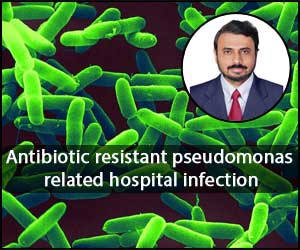- Home
- Editorial
- News
- Practice Guidelines
- Anesthesiology Guidelines
- Cancer Guidelines
- Cardiac Sciences Guidelines
- Critical Care Guidelines
- Dentistry Guidelines
- Dermatology Guidelines
- Diabetes and Endo Guidelines
- Diagnostics Guidelines
- ENT Guidelines
- Featured Practice Guidelines
- Gastroenterology Guidelines
- Geriatrics Guidelines
- Medicine Guidelines
- Nephrology Guidelines
- Neurosciences Guidelines
- Obs and Gynae Guidelines
- Ophthalmology Guidelines
- Orthopaedics Guidelines
- Paediatrics Guidelines
- Psychiatry Guidelines
- Pulmonology Guidelines
- Radiology Guidelines
- Surgery Guidelines
- Urology Guidelines
Bacterial resistance mechanism in pseudomonas related hospital infections- Dr BV Navaneeth

Inducible Amp C beta-lactamase producing Pseudomonas aeruginosa: predominant resistance mechanism and a threat in a tertiary care teaching hospital.
Purpose of the study
Pseudomonas aeruginosa nosocomial infections have become a worldwide healthcare issue due to their multidrug resistance mechanisms in hospital settings. P aeruginosa develops antibiotic resistance either by a genetic mutation within or borrow resistant genes from other bacteria. Usually, these resistances are mediated by enzymes like extended-spectrum beta-lactamases [ESBLs], Amp C beta-lactamases and Metallo-beta-lactamases [MBLs]. Management of infections becomes tough and expensive in the presence of these enzymes. An investigation was undertaken to find the occurrence of these enzymes for alerting the clinicians to enhance patient care and to design appropriate control measures.
Results
A total of 200 P aeruginosa were recovered from intensive care unit (25%), in patients (41.5%) and outpatients (33.5%). Isolates of P aeruginosa revealed 47.5% of inducible and 4% of non-inducible plasmid-mediated Amp C beta-lactamases. ESBLs and MBLs were 26% and 19% respectively. Highest resistance of 44% - 56% was noted to cephalosporins. Least resistance was recorded to colistin (2%), imipenem (19.5%) and amikacin (21.5%). Multi-drug resistant was found to be 37.5%. Overall resistance pattern were higher among ICU and inpatient isolates than outpatient isolates.
Take away
P aeruginosa is a major pathogen in hospital-acquired infections especially critical care units.
Inducible Amp C beta-lactamase was found to be a predominant mechanism of resistance. Usages of cephalopsorins are likely risk factor for developing inducible resistance among P aeruginosa. Colonization pressure, cross-transmission, and exposure to multiple antibiotics are the other important risk factors that need monitoring. Colistin, imipenem, and amikacin found to be useful first-line antibiotics with piperacillin-tazobactam and ciprofloxacin as alternatives. Furnishing well-timed report on the status of these enzymes by diagnostic laboratories will not only improve patient care but also aid in laying down appropriate control measures.
To learn more about the study please click on the link
http://www.japi.org/april_2019/12oa.html
Dr BV Navaneeth is Director-Professor at Department of Microbiology, ESIC Medical College and Hospital.
Dr Nandini MP is an assistant surgeon at Sri Jayadeva Institute of Cardiovascular Sciences and Research, Bangalore.

Disclaimer: This site is primarily intended for healthcare professionals. Any content/information on this website does not replace the advice of medical and/or health professionals and should not be construed as medical/diagnostic advice/endorsement or prescription. Use of this site is subject to our terms of use, privacy policy, advertisement policy. © 2020 Minerva Medical Treatment Pvt Ltd